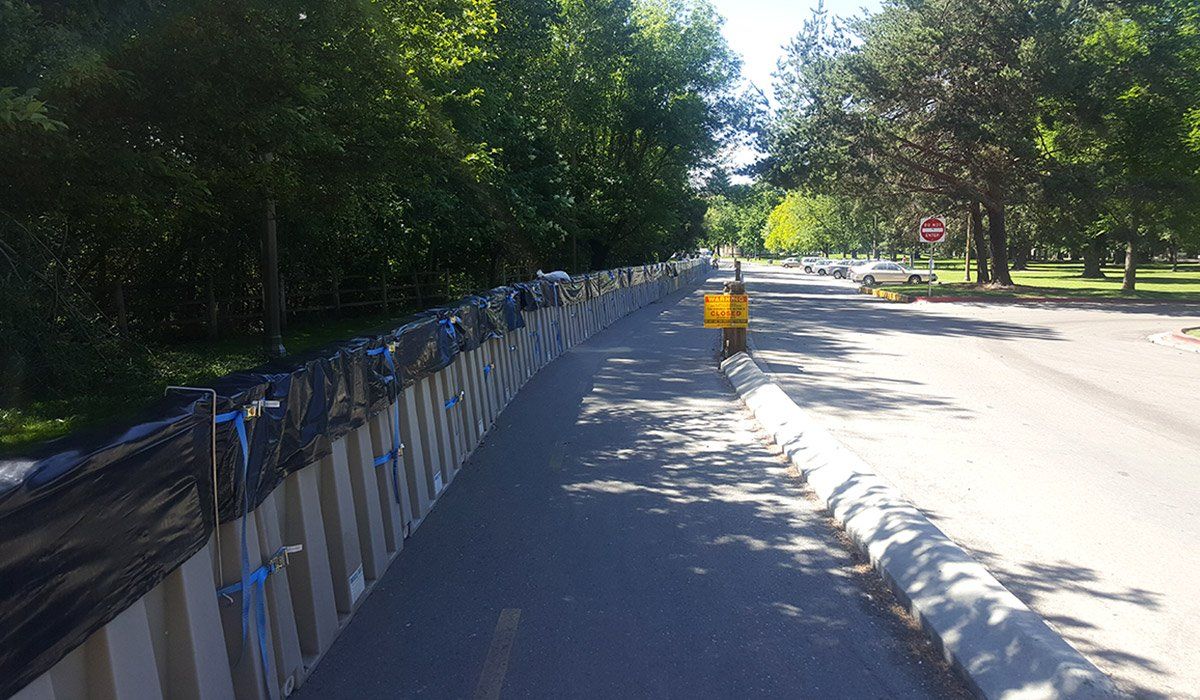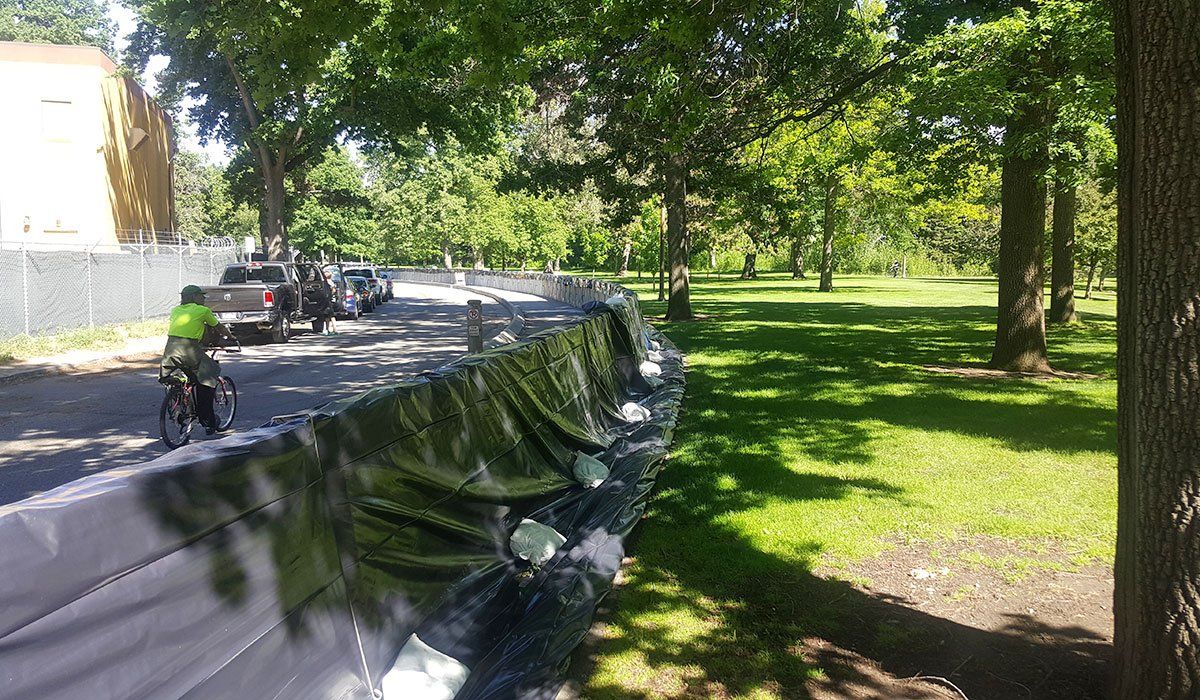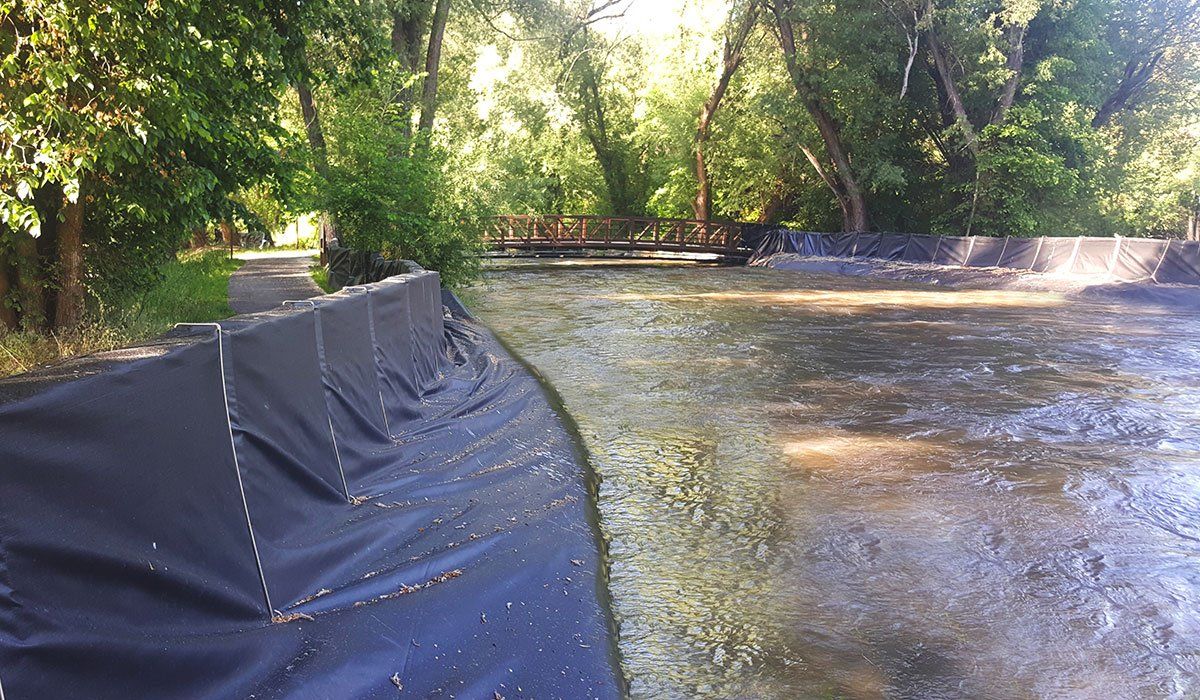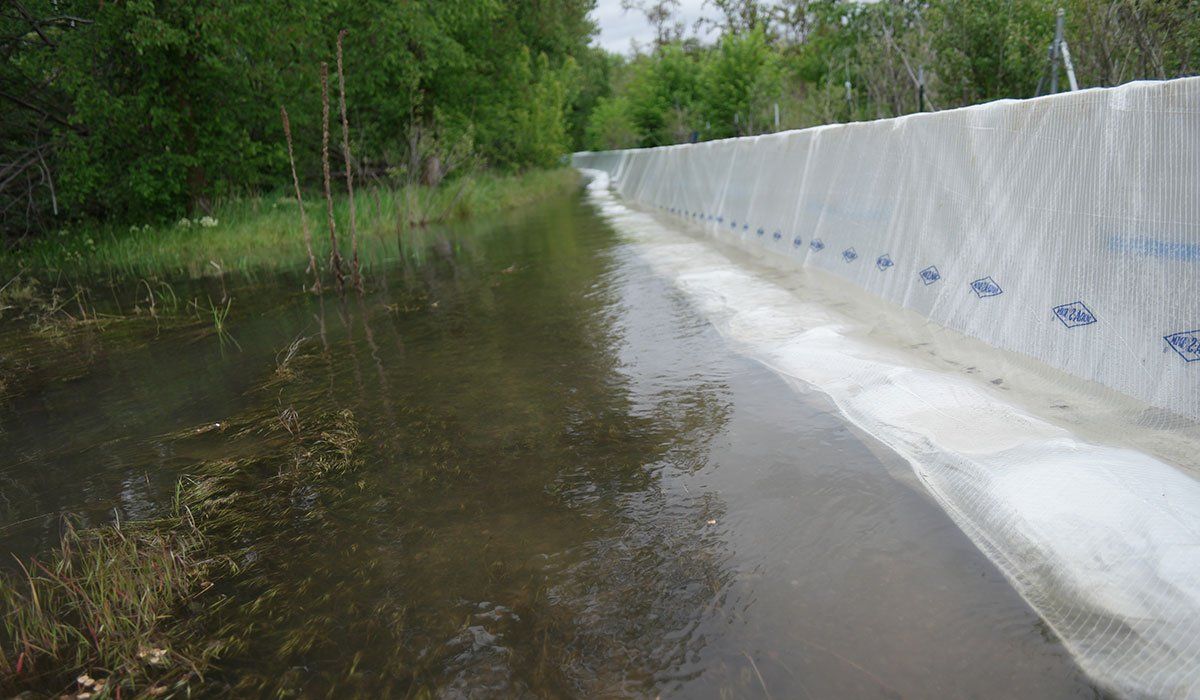Ada County installing Muscle Wall flood barriers on Greenbelt
Gretchen Parsons • May 11, 2017
Ada County emergency officials are making one last preventative effort to protect the Sunroc gravel pit before Boise River flows increase next week.
Crews were working along the Greenbelt Thursday morning to install this latest series of barriers.
The county has put up what is called a “muscle wall” to supplement the diversion tubes that were put in place last week.
It's essentially a two-foot-tall barrier filled with river water that stretches 600 feet and is designed to stop water from going over the Greenbelt, which would contribute to the possibility of a pit capture.
This is all an effort to prevent a pit capture at the Sunroc gravel pit and to prevent a nearby farm field from flooding.
This barrier is going up on a section of the Greenbelt that's about 1,000 feet east of the gravel pit.
Ada County engineer Angie Gilman says before water is released next week this is the last effort to prepare for a pit capture where river water could be diverted in any direction.
“Eventually it would head downstream but we don't know how soon it would get back into south channel, you could try and do it somewhere in vicinity of the gravel pit, but no guarantee that we can catch it there and get it back in, otherwise it would just head west into the subdivisions and Eagle Road," said Gilman.
The muscle wall connects together like Lincoln Logs.
“They're very light and they connect in place quite easily, so you don't need special labor or what have you, you can carry them into flood zone and then connect them as fast as you can carry them into place," said Keith Anderson, owner Flood Resolutions.
And it is held in place by gravity.
“We have this tow on the front side, and what the tow does is, essentially the water sits on top of this barrier and the downward pressure on this bottom tow prevents them from moving or rolling," said Anderson.
About 600 feet of barrier was laid down along the Greenbelt Thursday morning.
Anderson owns Flood Resolutions. Although he's be in business for 15 years, this is his company's first large-scale project here locally.
“We have never done anything in Idaho, we have been here my whole life, and in my experience I have never seen flooding similar to what we are having right now," said Anderson.
Now, all officials can do is wait.
“This is like, let's get this done because we anticipate flows increasing, from now on it will be more watching and waiting with trees falling and chasing those sorts of things, but this is probably the last defense measure we will be taking," said Gilman.
When there is no longer a concern for flooding, Anderson says the muscle wall can be drained and packed up just as quick as it was laid down and reused for the next flood season.
Coastal communities face an ongoing battle against ocean forces that threaten valuable beachfront properties. The Capistrano Beach, California case study provides a compelling example of effective long-term coastal protection using modern barrier systems. The Capistrano Beach Challenge Since 2005, residents of the Capistrano Beach district have been armoring their beachfront to protect it against an advancing ocean. Coastal protection strategies and products vary in cost, size, effectiveness, and life span. Engineering Assessment and Solution ENGEO's comprehensive case study, completed in June 2021, evaluated the performance of Muscle Wall systems installed along Capistrano Beach. The assessment highlighted key performance metrics and long-term effectiveness. Craig Wright, ENGEO Case Study Author, reported: "Muscle Wall has proven to be an agile, resilient, and durable shoreline erosion product. Muscle Wall can be rapidly deployed before a storm, and can outperform other short-term beach erosion mitigation solutions in terms of their longevity and resistance to degradation and beach pollution." Long-Term Performance Data The Capistrano Beach installation provides valuable long-term performance data: Duration of Service Muscle Wall systems have been continuously installed in the Capistrano Beach area for over 5 years, providing extensive real-world performance data. Structural Integrity Throughout the 5+ year installation period, the systems have "received no structural damage or movements during that time," demonstrating exceptional durability under constant ocean exposure. Asset Protection Value The installations have successfully protected "millions of dollars worth of assets," highlighting the significant economic value of effective coastal protection. ENGEO's Expectation "We expect the Muscle Wall barriers to withstand continued use for years to come." Technical Installation Approach Anchoring System The walls are anchored into the sand, allowing the waves to pound into the Muscle Wall system, and not eat away at the sand of the valuable coastline. Wave Energy Management Rather than deflecting wave energy, the system allows waves to impact the barrier system while protecting the underlying coastline from erosion. Environmental Integration The deployment procedure is a quick and easy setup and removal process by a few people with no heavy equipment required. The entire Muscle Wall deployment process can be safely completed by a two person team. Coastal Protection Benefits Bridge Solution Muscle Wall provides a perfect bridge between a short-term solution and a permanent structure, offering flexibility for evolving coastal management needs. Rapid Storm Response Systems can be rapidly deployed before storm events, providing emergency protection when coastal conditions deteriorate. Modular Adaptability The modular design of the system, as well as the various heights offered, allows the user to customize the product to fit the size of their project. Material Durability UV Protection The linear low-density polyethylene (LLDPE) material construction includes a 10-year manufacturer's UV warranty, enabling outdoor storage and extended deployment periods. Chemical Resistance The Linear Low-Density Polyethylene (LLDPE) used to create Muscle Wall is the same material that is used to create containers to store harsh chemicals, providing excellent resistance to salt water and marine environments. Long-Term Performance The durable material used to create Muscle Wall and its supporting liner allows for the product to be viewed as both a temporary or permanent solution, as well as making it reusable for multiple applications. ENGEO Professional Recognition The success of the Capistrano Beach installation led to ENGEO's approval of Muscle Wall as a Multi-Use Best Management Practice, providing professional validation for coastal erosion applications. Economic Considerations Initial Investment vs. Long-Term Value While initial barrier system costs may exceed traditional solutions, the 5+ year performance data demonstrates superior long-term value through: Elimination of replacement costs Reduced maintenance requirements Continuous asset protection value Property Value Protection Effective coastal protection maintains and enhances beachfront property values by preventing erosion-related damage and loss. Environmental Compatibility Pollution Prevention Unlike some traditional coastal protection methods, Muscle Wall systems resist degradation and beach pollution, maintaining environmental quality. Aesthetic Integration At Muscle Wall, our priority is the safety of the customer, the community, and the environment. The product nestles into the environment in a non-invasive manner, offering protection and safety, while not taking away from the beauty and value of the landscape and property. The Capistrano Beach case study provides compelling evidence that modern barrier systems can deliver effective, long-term coastal protection while maintaining environmental compatibility and economic value. For coastal communities evaluating erosion protection options, the 5+ year performance record offers valuable validation of Muscle Wall system effectiveness in challenging marine environments.
Wildfire devastation extends far beyond the initial burn. When vegetation is destroyed, soil becomes loose and unstable, creating severe flood and erosion risks during subsequent rainfall. The Fruita, Colorado case study demonstrates how proactive flood control measures can protect valuable properties from post-fire devastation. The Post-Fire Flooding Challenge After wildfires sweep through an area, the landscape becomes vulnerable to secondary disasters: Burned vegetation leaves soil loose and exposed Heavy rainfall creates flash flood conditions Debris flow carries mud, rocks, and organic matter Property damage can exceed original fire losses Fruita, Colorado Success Story In spring 2021, fires ravaged the landscape surrounding Fruita, Colorado. Anticipating post-fire flood risks, Kuersten Construction and SGM Engineering implemented proactive flood control measures before the rain season. The Implementation 4-foot Muscle Wall systems were installed prior to heavy rainfall events Strategic placement protected large ranches and residential properties Multiple flood events tested the system's effectiveness The Results During subsequent flood events: Flood waters rose within 2 inches of the 4-foot wall tops Water and mud were successfully retained throughout multiple events Protected homes and properties sustained no damage The Muscle Wall system itself remained undamaged and functional Engineering Excellence Recognition The Fruita project's success earned recognition from the U.S. Forest Service, which awarded the contractor the Aquatic Stewardship Award for 2024, highlighting the environmental and property protection benefits of proactive flood control. Property Owner Testimony "WE BELIEVE IN YOUR PRODUCT! THE MUSCLE WALL IS THE ONLY BARRIER BETWEEN OUR CABINS AND THE RAGING RIVER," reported Malli Larson, a protected property owner. Tyler Searle, Muscle Wall Technical Engineer, noted: "Nothing is more rewarding than engineered preparation meeting and conquering what could have been a catastrophic storm event. Huge thank you to SGM Inc. & Kuersten Construction LLC, Mesa County, and the Colorado USDA-NRCS for their help protecting this Colorado Residents' property." Technical Advantages for Post-Fire Applications Modern barrier systems offer specific benefits for post-fire flood control: Rapid Response Capability An experienced crew of four people can fully deploy 100 feet of 2-foot Muscle Wall in normal conditions in about 30 minutes, providing flexibility during unpredictable post-fire recovery periods. Customizable Configuration Modular 6-foot sections allow for custom configurations around existing structures and terrain features. The patented connections pivot 11 degrees forward and backward, enabling the system to adapt to uneven terrain and meander to fit most circumstances. Dual-Purpose Design Muscle Wall was designed as a very rapid deployment system in cases of emergency, but there is no reason it can't be left deployed over the long-term, with customers who have had systems deployed for many years. Environmental Compatibility The system nestles into the environment in a non-invasive manner, offering protection and safety, while not taking away from the beauty and value of the landscape and property. Professional Implementation Success in post-fire applications requires proper engineering and installation: Site assessment by qualified engineers Strategic placement based on water flow patterns Coordination with local emergency management teams Integration with broader watershed protection strategies For communities in fire-prone regions, proactive flood control planning can prevent post-fire property losses that often exceed the original fire damage. The Fruita case study demonstrates that proper preparation and modern barrier technology can effectively protect both physical assets and financial investments during vulnerable post-fire recovery periods.
Professional flood control equipment requires rigorous testing and certification to ensure reliability during critical emergency situations. Understanding these certifications helps emergency management professionals make informed decisions about flood protection investments. The Importance of Professional Certifications Emergency management teams cannot afford equipment failures during flood events. Professional certifications provide assurance that flood control systems will perform as specified when communities face rising waters. U.S. Army Corps of Engineers (USACE) Certification The U.S. Army Corps of Engineers maintains the nation's most rigorous flood control testing standards. USACE certification involves comprehensive testing at their Vicksburg, Mississippi laboratory facility. Testing Parameters USACE testing evaluates flood control systems across multiple performance criteria to ensure reliability during emergency deployment. Certificate of Compliance Muscle Wall has received USACE Certificate of Compliance for 2-foot, 3-foot, and 4-foot Muscle Wall products, demonstrating consistent performance across multiple height options. Real-World USACE Usage The USACE has purchased Muscle Wall on multiple occasions to be used to protect critical infrastructure at lock and dams along the Mississippi River, providing real-world validation of the system's effectiveness. FM Approval Certification FM Approvals represents the gold standard in third-party testing and certification services. As an international leader in property loss prevention, FM Approvals employs rigorous testing backed by over a century of experience. The FM APPROVED Mark The FM APPROVED mark is recognized and respected worldwide by: Engineering firms specifying flood control equipment Insurance companies evaluating risk mitigation measures Emergency management professionals selecting reliable systems Muscle Wall holds the distinction of being the only flood control barrier to receive FM Approval at 4 feet high, representing a significant technical achievement in barrier engineering. Industry Recognition The FM APPROVED mark is recognized and respected worldwide. This certification is the gold standard in which engineering firms and insurance companies place their trust, and instills confidence and commands respect in the marketplace. ENGEO Multi-Use Best Management Practice Approval ENGEO, a leading geotechnical engineering firm, has approved Muscle Wall as a Multi-Use Best Management Practice. This approval recognizes the versatility and effectiveness of modular barrier systems across diverse applications. Real-World Validation Professional certifications are supported by extensive field deployment: Over 80 miles of Muscle Wall product deployed by municipalities, businesses, and property owners around the United States Successful applications in coastal, riverine, and post-disaster environments Multiple testing and certifications from U.S. Army Corps, FM Approvals, multiple water labs Emergency Protective Measures Eligibility Certified flood control systems qualify for FEMA Emergency Protective Measures reimbursement, providing financial benefits to communities that invest in professional-grade flood protection. Reimbursement Benefits Pre-event mitigation investments may qualify for federal reimbursement Professional certifications support reimbursement applications Demonstrated effectiveness reduces overall disaster recovery costs Selection Criteria for Emergency Management When evaluating flood control systems, emergency management professionals should consider: Certification Portfolio USACE testing and Certificate of Compliance FM Approval status Industry-specific approvals (ENGEO Multi-Use Best Management Practice) Deployment Specifications Time requirements for emergency deployment (30 minutes for 100 feet with 4-person crew) Personnel and equipment needs Storage and maintenance requirements Performance Documentation Field deployment history (80+ miles deployed) Case studies and success stories Professional references and testimonials Long-Term Value Proposition Certified flood control systems provide multiple benefits: Reliable performance during emergencies Reusable infrastructure spanning decades (10-year UV warranty) Federal reimbursement eligibility Professional credibility with stakeholders For emergency management teams responsible for community protection, professional certifications provide essential assurance that flood control investments will perform when needed most. The combination of USACE certification, FM Approval, and extensive field validation creates a compelling case for modern barrier systems in professional flood control applications.
When emergency management teams face rising flood waters, every minute counts. Traditional sandbag operations require extensive labor, heavy equipment, and time that emergency responders simply don't have. But what if you could deploy 100 feet of effective flood barriers in just 30 minutes with a 4-person crew? The Traditional Challenge Conventional flood control methods present significant operational challenges: Sandbag deployment for 100 feet takes "well over a day" Requires heavy equipment and extensive labor Limited reusability after flood events Significant cleanup and disposal costs According to the United States Army Corps of Engineers recommended sandbag deployment procedures, the true expense of sandbags, once you factor in cleanup and other costs, ranges from $2.50 to $5.00 per bag. Modern Flood Barrier Technology Advanced barrier systems like Muscle Wall have revolutionized emergency flood response. With FM Approval and U.S. Army Corps of Engineers certification, these modular systems offer dramatic improvements over traditional methods. An experienced crew of four people can fully deploy 100 feet of 2-foot Muscle Wall in normal conditions in about 30 minutes. This represents a dramatic time savings compared to traditional methods where "sandbags would take well over a day" for the same 100-foot distance. While Muscle Wall can be set up without any heavy equipment, it is recommended to have a forklift available to offload pallets from the truck and to transport during the deployment phase. However, the core deployment process requires no heavy machinery. The entire Muscle Wall deployment process can be safely completed by a two-person team, providing flexibility during emergency situations when crew availability may be limited. Unlike single-use sandbags, modern barrier systems are designed for repeated deployment. The linear low-density polyethylene (LLDPE) construction includes a 10-year manufacturer's UV warranty, allowing for decades of storage and reuse. Real-World Applications Coastal Protection In Capistrano Beach, California, Muscle Wall systems have protected beachfront properties for over 5 years without structural damage or movement, safeguarding millions of dollars in coastal assets. Post-Fire Flood Control Following wildfire events in Fruita, Colorado, 4-foot Muscle Wall systems successfully contained flood waters and mud during multiple flood events, with water levels rising within 2 inches of the wall tops. The contractor received the U.S. Forest Service Aquatic Stewardship Award for 2024 for this project. Emergency Management Benefits For emergency management professionals, rapid deployment capabilities translate to: 30-minute deployment vs. "well over a day" for traditional methods Reduced labor requirements during emergency situations Reusable assets that provide long-term value FEMA Emergency Protective Measures eligibility for reimbursement Technical Certifications Modern flood barrier systems undergo rigorous testing: U.S. Army Corps of Engineers Certificate of Compliance for 2-foot, 3-foot, and 4-foot systems FM Approval (Muscle Wall is the only flood control barrier to receive FM Approval at 4 feet high) Multi-Use Best Management Practice approval from ENGEO Field Deployment History Over 80 miles of Muscle Wall product has been deployed by municipalities, businesses, and property owners around the United States, demonstrating extensive real-world validation. When communities face flood threats, the ability to deploy effective barriers in 30 minutes instead of "well over a day" can mean the difference between property protection and catastrophic damage.

The waters of the Boise River are rising, but to protect animals at the Zoo Boise from potential flooding, the city is building a "muscle wall," not an Ark. The wall will be a 2-foot-high, 2,000-foot-long water-filled bladder between the zoo and river. Construction of the barrier will close Julia Davis Drive from the bandshell to the tennis courts, but the Friendship Bridge between the park and Boise State University will remain open to pedestrian and bike traffic. Evacuating Zoo Boise would cost the city of Boise $500,000-$600,000, according to city officials, while the $130,000 barrier has been touted as the most cost-effective solution to potential flooding. Another consideration, zoo officials said, would be the potential distress caused to the more than 200 animals should they need to be relocated. A wall similar to the one used to protect the zoo was deployed to hold back floodwaters at a gravel pit near Eagle Island in May. Flows on Boise River measured 9,300-9,500 cubic feet per second Tuesday and Wednesday at the Glenwood Bridge. That's the highest flow rate in the past 35 years by more than 1,000 feet per second. Meanwhile, federal water managers have warned the city flows may increase in the coming week as warm weather persists and upstream reservoirs reach capacity. High water has been a consistent challenge this spring. Boise Mayor Dave Bieter and Garden City Mayor John Evans closed most sections of the greenbelt April 14, and those sections have remained off limits to the public ever since.

On Wednesday, the City of Boise will began taking precautionary measures to protect Zoo Boise in the event that hot weather this week and fast-filling reservoirs force federal water managers to release more water into the Boise River, according to a news release. City engineers and other agency partners with the Ada County-wide team working to manage flood response Tuesday began preparations to install a 2,000-foot-long, four- to two-foot-tall “muscle wall” flood barrier. “The structure is similar to the wall constructed to protect a gravel pit near Eagle Island last month,” said City spokesman Mike Journee. “Zoo Boise managers and emergency responders are taking the proactive step because of the difficult logistics, expense and potential stress to animals if relocating the Zoo’s more than 200 animals became necessary. Additionally, federal water managers are now saying that this week’s significantly warmer weather and quickly shrinking capacity in upstream reservoirs means that notice of river flow increases could come just 24 hours in advance. That would give zoo managers little time to plan an animal evacuation, if needed,” he added. “We are doing this out of an abundance of caution to ensure we are not faced with planning a full-scale evacuation of zoo animals on short notice,” said Doug Holloway, Director of Parks and Recreation for the City of Boise. “The investment to protect the animals and zoo property is a good one, given the circumstances.” The construction of the flood barrier will force the closure of Julia Davis Drive between the bandshell and tennis courts. Friendship Bridge, the pedestrian bridge between Boise State University and Julia Davis Park, will remain open to through-traffic for pedestrians and bike traffic. However, the Greenbelt through the park and the entire city remains closed due to the high water and safety concerns. “The conditions on the Boise River and the Greenbelt become more dangerous as time goes by and the water undermines the tree roots and the foundation of the Greenbelt,” said Boise Fire Chief Dennis Doan. “These conditions are potentially fatal to the public and first responders. We ask all residents to respect this closure to prevent any tragedies.” Evacuating the more than 200 animals at Zoo Boise would cost approximately $500,000 to $600,000, plus post-flood clean-up costs and revenue lost with the zoo’s closure, officials said. “Additionally, such a move would could be extremely stressful to many of the animals. The flood barrier is expected to cost approximately $130,000 and cause animals little or no concern. Of that cost, $118,500 will be covered by grant funds from Ada County Emergency Management. Installation is expected to take one or two days and the barrier will remain in place until the zoo is no longer threatened by high water,” Journee stated. Currently, the Boise River is flowing at approximately 9,300 cubic feet per second. While federal water managers have no immediate plans of increasing those flows, they have warned city and county officials that current weather conditions likely mean advanced warning of just 24 hours if and when increases are necessary -- much shorter than the three- to four-day window of previous weeks.

A long line of plastic barriers has appeared on the north riverbank as it snakes through the Logan River Golf Course. It’s a product called Muscle Wall and is expected to ease flooding worries as spring runoff have created flood watch conditions. Logan Parks and Recreation Director Russ Akina said the city purchased 600 wall segments about two weeks ago for just under $350,000. Akina said he feels confident that the Muscle Wall will prevent flooding along the golf course like Logan saw in 2011. The plastic, 6-foot-long wall segments — some 2 feet tall and some 4 feet tall — are hollow. Two people can easily lift a segment and drop the interlocking pivots into place, creating a continuous barrier. Then, they are filled with water and a tarp is draped over the top to prevent erosion underneath the Muscle Wall. Akina said city engineers have surveyed the Logan River and identified areas with low riverbanks, where water is dangerously close to overflowing. Based on reports from the National Weather Service in Salt Lake City, Akina said they are taking measures to prevent flooding. “We’re trying to stay ahead of the anticipated runoff to protect areas, whether that is residential property or city property, including the golf course,” Akina said. In 2011, large sections of the Logan River Golf Course were underwater. Roughly three weeks ago, Akina said, a section of the riverbank that failed in 2011 was six inches from flooding the bank. That encouraged Logan to look into options besides sandbags. He said approximately 300 sandbags would be needed for each segment of Muscle Wall, meaning somewhere in the tens of thousands would be needed along the river. “That’s a lot of sandbags, so as an alternative to that, we decided to go with this Muscle Wall in place of that,” Akina said. Muscle Walls are easier to install and can be reused year after year, while sandbags are heavy, labor-intensive and don’t last more than one season. “It’s much faster and more efficient for us to be able to move sections of wall, store them and then have them back ready to use when we have to do this again,” Akina said. Large sections of the wall were installed Saturday, and workers filled in other sections Monday. Akina said they are waiting for tarp anchors to be delivered, but as soon as they arrive the tarps will be set up and the Muscle Wall will stand ready. Along a residential section of the river, in the Sumac area, Public Works Director Mark Nielsen said city employees will place sandbags Monday night where houses back up to the Logan River. The river is running high and fast, but cooler temperatures are expected to bring some relief. “The river thus far has behaved very well,” Nielsen said. “It’s hot for a while, then it cools down, and that’s a great help to us to keep it where it should be.”

Ada County is making a final effort to protect a gravel pit on Eagle Island, installing a 600-foot “muscle wall” between the Boise River and the farm field next to the pit. The wall is 2 feet tall and is directly beside the 4,000-foot temporary levee installed by the U.S. Army Corps of Engineers and the 600-foot flood diversion tube put in by Ada County last month, according to the Eagle Police Department. The tube is near the head of Eagle Island to bolster an area where swift water has eroded sections of the riverbank. So now there is a physical barrier between the river and the pit stretching all the way to the Garden City border at Duck Lake Drive. The privately owned gravel pit is near the east end of Eagle Island, not far from the Island Woods and Two Rivers neighborhoods. Officials have been worried that if that area floods, it would change the course of the river and send water in directions experts can only guess.

